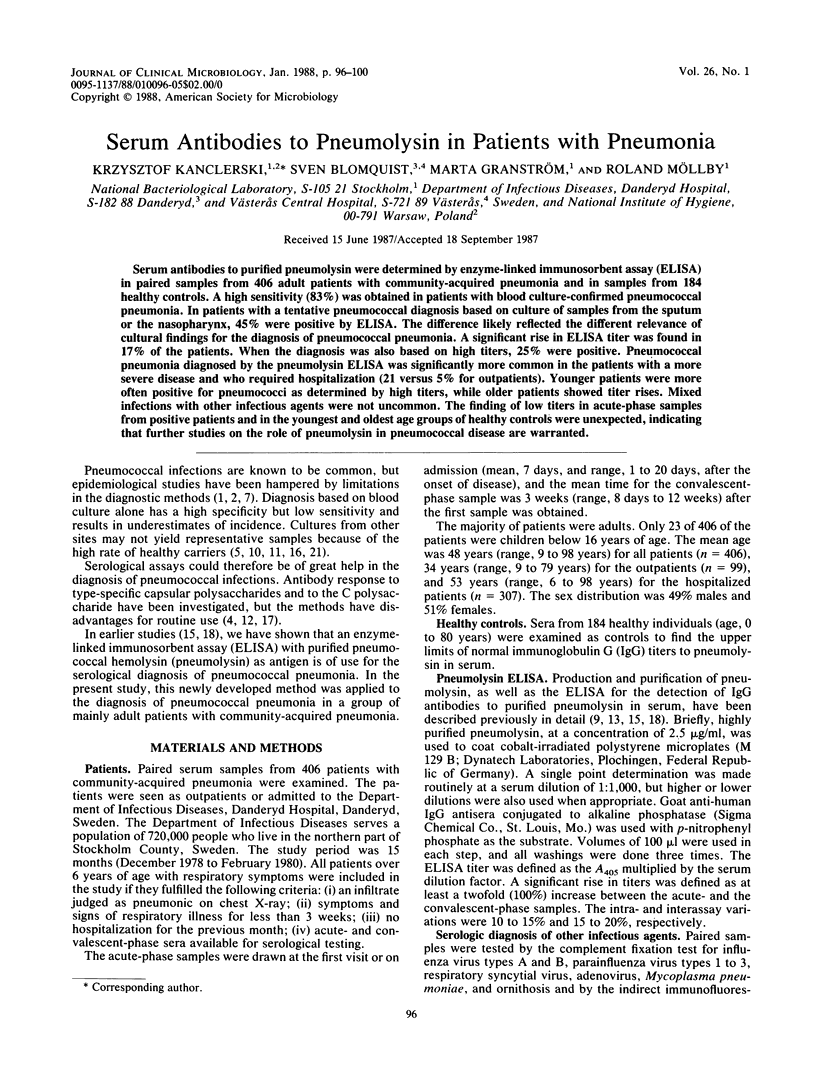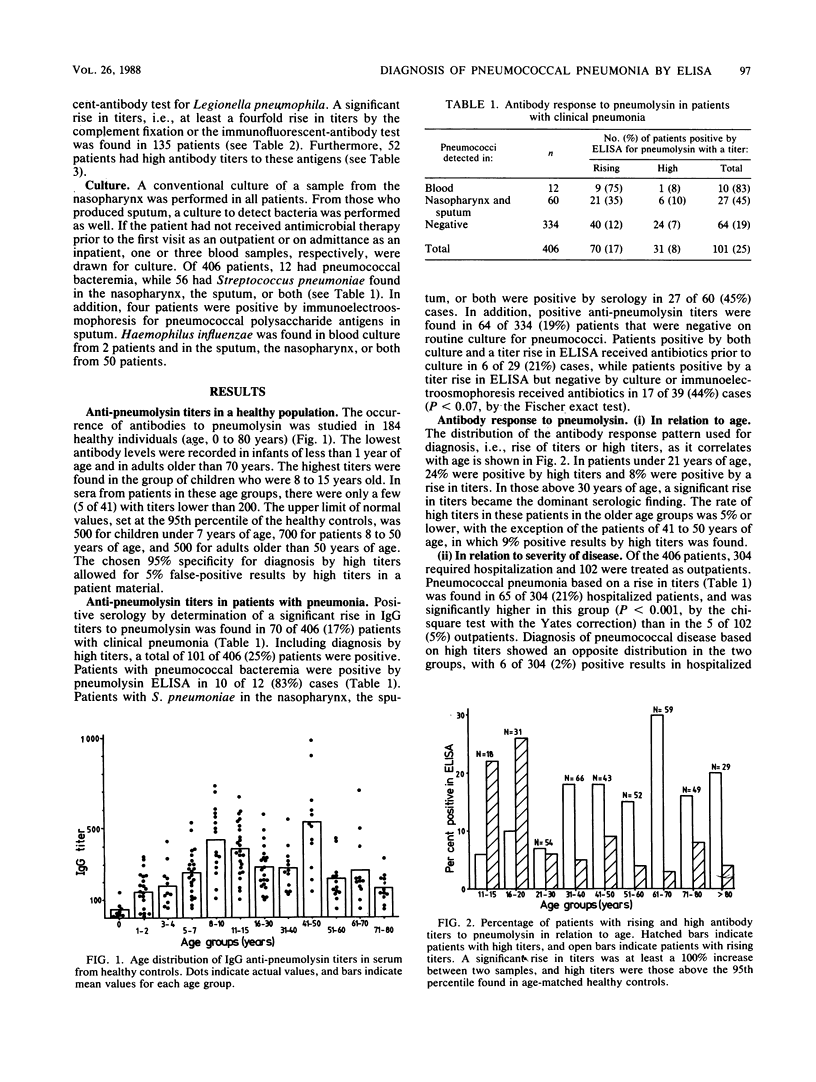Abstract
Serum antibodies to purified pneumolysin were determined by enzyme-linked immunosorbent assay (ELISA) in paired samples from 406 adult patients with community-acquired pneumonia and in samples from 184 healthy controls. A high sensitivity (83%) was obtained in patients with blood culture-confirmed pneumococcal pneumonia. In patients with a tentative pneumococcal diagnosis based on culture of samples from the sputum or the nasopharynx, 45% were positive by ELISA. The difference likely reflected the different relevance of cultural findings for the diagnosis of pneumococcal pneumonia. A significant rise in ELISA titer was found in 17% of the patients. When the diagnosis was also based on high titers, 25% were positive. Pneumococcal pneumonia diagnosed by the pneumolysin ELISA was significantly more common in the patients with a more severe disease and who required hospitalization (21 versus 5% for outpatients). Younger patients were more often positive for pneumococci as determined by high titers, while older patients showed titer rises. Mixed infections with other infectious agents were not uncommon. The finding of low titers in acute-phase samples from positive patients and in the youngest and oldest age groups of healthy controls were unexpected, indicating that further studies on the role of pneumolysin in pneumococcal disease are warranted.
Full text
PDF




Selected References
These references are in PubMed. This may not be the complete list of references from this article.
- Austrian R. Some observations on the pneumococcus and on the current status of pneumococcal disease and its prevention. Rev Infect Dis. 1981 Mar-Apr;3 (Suppl):S1–17. doi: 10.1093/clinids/3.supplement_1.s1. [DOI] [PubMed] [Google Scholar]
- Barrett-Connor E. The nonvalue of sputum culture in the diagnosis of pneumococcal pneumonia. Am Rev Respir Dis. 1971 Jun;103(6):845–848. doi: 10.1164/arrd.1971.103.6.845. [DOI] [PubMed] [Google Scholar]
- Berntsson E., Blomberg J., Lagergård T., Trollfors B. Etiology of community-acquired pneumonia in patients requiring hospitalization. Eur J Clin Microbiol. 1985 Jun;4(3):268–272. doi: 10.1007/BF02013650. [DOI] [PubMed] [Google Scholar]
- Coonrod J. D., Drennan D. P. Pneumococcal pneumonia: capsular polysaccharide antigenemia and antibody responses. Ann Intern Med. 1976 Mar;84(3):254–260. doi: 10.7326/0003-4819-84-3-254. [DOI] [PubMed] [Google Scholar]
- Davidson M., Tempest B., Palmer D. L. Bacteriologic diagnosis of acute pneumonia. Comparison of sputum, transtracheal aspirates, and lung aspirates. JAMA. 1976 Jan 12;235(2):158–163. [PubMed] [Google Scholar]
- Fransén H., Wolontis S. Infections with viruses, Mycoplasma pneumoniae and bacteria in acute respiratory illness. A study of hospitalized patients, patients treated at home, and healthy subjects. Scand J Infect Dis. 1969 May;1(1):31–37. doi: 10.3109/inf.1969.1.issue-1.05. [DOI] [PubMed] [Google Scholar]
- Granström M., Julander I. G., Hedström S. A., Möllby R. Enzyme-linked immunosorbent assay for antibodies against teichoic acid in patients with staphylococcal infections. J Clin Microbiol. 1983 Apr;17(4):640–646. doi: 10.1128/jcm.17.4.640-646.1983. [DOI] [PMC free article] [PubMed] [Google Scholar]
- Gray B. M., Converse G. M., 3rd, Dillon H. C., Jr Epidemiologic studies of Streptococcus pneumoniae in infants: acquisition, carriage, and infection during the first 24 months of life. J Infect Dis. 1980 Dec;142(6):923–933. doi: 10.1093/infdis/142.6.923. [DOI] [PubMed] [Google Scholar]
- Hendley J. O., Sande M. A., Stewart P. M., Gwaltney J. M., Jr Spread of Streptococcus pneumoniae in families. I. Carriage rates and distribution of types. J Infect Dis. 1975 Jul;132(1):55–61. doi: 10.1093/infdis/132.1.55. [DOI] [PubMed] [Google Scholar]
- Holmberg H., Krook A., Sjögren A. M. Determination of antibodies to pneumococcal C polysaccharide in patients with community-acquired pneumonia. J Clin Microbiol. 1985 Nov;22(5):808–814. doi: 10.1128/jcm.22.5.808-814.1985. [DOI] [PMC free article] [PubMed] [Google Scholar]
- Julander I. G., Granström M., Hedström S. A., Möllby R. The role of antibodies against alpha-toxin and teichoic acid in the diagnosis of staphylococcal infections. Infection. 1983 Mar-Apr;11(2):77–83. doi: 10.1007/BF01641071. [DOI] [PubMed] [Google Scholar]
- Kalin M., Kanclerski K., Granström M., Möllby R. Diagnosis of pneumococcal pneumonia by enzyme-linked immunosorbent assay of antibodies to pneumococcal hemolysin (pneumolysin). J Clin Microbiol. 1987 Feb;25(2):226–229. doi: 10.1128/jcm.25.2.226-229.1987. [DOI] [PMC free article] [PubMed] [Google Scholar]
- Kalin M., Lindberg A. A. Diagnosis of pneumococcal pneumonia: a comparison between microscopic examination of expectorate, antigen detection and cultural procedures. Scand J Infect Dis. 1983;15(3):247–255. doi: 10.3109/inf.1983.15.issue-3.04. [DOI] [PubMed] [Google Scholar]
- Paton J. C., Lock R. A., Hansman D. J. Effect of immunization with pneumolysin on survival time of mice challenged with Streptococcus pneumoniae. Infect Immun. 1983 May;40(2):548–552. doi: 10.1128/iai.40.2.548-552.1983. [DOI] [PMC free article] [PubMed] [Google Scholar]
- Rosén C., Christensen P., Hovelius B., Prellner K. A longitudinal study of the nasopharyngeal carriage of pneumococci as related to pneumococcal vaccination in children attending day-care centres. Acta Otolaryngol. 1984 Nov-Dec;98(5-6):524–532. doi: 10.3109/00016488409107593. [DOI] [PubMed] [Google Scholar]


